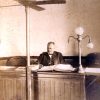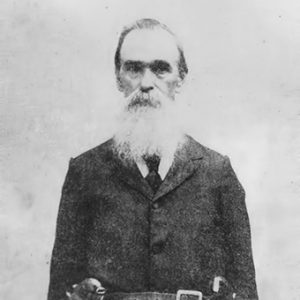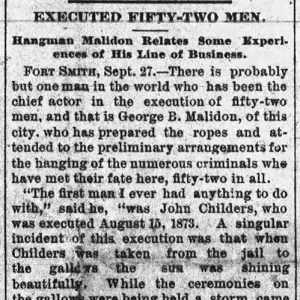calsfoundation@cals.org
George Maledon (1830–1911)
While much of his life is shrouded in legend, according to a number of sources, George Maledon was the most prolific executioner in the United States in the last third of the nineteenth century. Working as the hangman for the famed Judge Isaac Parker for the U.S. District Court for the Western District of Arkansas in Fort Smith (Sebastian County), he reportedly performed as many as eighty-one executions, although more recent historical accounts put the number at closer to fifty.
George Maledon was born in Germany on June 10, 1830. He immigrated with his parents, about whom little is known, to the United States, settling in the Detroit, Michigan, area, where they joined the small German Catholic community that had developed there. As a young man, he headed west from Detroit, first working at a lumber mill for the Choctaw Nation in Indian Territory. In the later 1850s, Maledon got a job on the Fort Smith police force. During the Civil War, Maledon served with the Union army in the First Arkansas Light Artillery Battery.
Following the Civil War, Maledon returned to Fort Smith. He apparently secured a job with the Western District’s federal court, serving as a guard with the U.S. marshals in 1871. The following year, he worked as a deputy sheriff in Fort Smith, where he was said to have shot two prisoners who had attacked him during a jail break. By fall 1873, he was again working as a guard, and in October he was reported to have assisted in an execution under the direction of Charley Messler, the primary executioner.
In March 1875, Maledon left the marshal’s office and returned to local law enforcement, assuming the post of deputy town constable in Fort Smith. In May, Judge Parker held court in Fort Smith for the first time, and according to some local news reports, it was later that summer when Parker ordered, and Maledon carried out, his first executions. There are conflicting reports, however, that challenge the date of that first execution. Complicating the effort to get at the truth was Maledon’s own admission that he had not kept records of the executions he had done.
In 1894, Maledon apparently retired from the federal court and opened a grocery store in Fort Smith. Then, in the mid-1890s, encouraged by a local publicity-savvy attorney, Maledon began touring with mementos of his years as a hangman. With ropes and pieces of gallows beams, as well as a set of photographs that made up a kind of hall of fame of those he had executed, he regularly drew large crowds to the various fairs and shows where he offered the display. In addition, his reputation was furthered by the publication of a book, Hell on the Border, which Maledon helped market through his continuing tours.
In his later years, he was said to have moved to Rogers (Benton County), where he had a farm, before eventually returning to Fort Smith, where he lived until 1905, when he moved to a soldiers’ home in Johnson City, Tennessee.
While there is agreement that Maledon, who had experienced ill health, died of dementia while living in the soldiers’ home in Tennessee, the reason why he had moved there, almost 800 miles away from Fort Smith, remains unclear. His tombstone at the Mountain Home National Cemetery in Johnson City lists no birth or death date, and while the Fort Smith National Historic Site lists the date of his death as June 5, 1911, other sources say it was May 6. Similar mystery surrounds his family life. There are reports that he married young but that his first wife died. He later married Mary Maledon, who survived him. By all accounts, he had numerous children, with several reports setting the total at twelve, and at the time of his death he was known to have three sons still living in the Fort Smith area.
For additional information:
Bartlett, Marie. “The Prince of Hangmen?” True West: History of the American Frontier, April 28, 2015. Online at https://truewestmagazine.com/the-prince-of-hangmen/ (accessed April 24, 2019).
“Famous Hangman of Ft. Smith Dead.” Arkansas Gazette, May 31, 1911, p.7.
“George Maledon—Prince of Hangmen.” Legends of America. https://www.legendsofamerica.com/ar-georgemaledon/ (accessed April 24, 2019).
“He’s Killed Many Men.” Missoula Weekly Gazette (Missoula, Montana), February 10, 1892.
“Prince of Hangmen.” Fort Smith National Historic Site. https://www.nps.gov/fosm/learn/historyculture/prince-of-hangmen.htm (accessed April 24, 2019).
Underhill, Lonnie E. “George Isaac Maledon, Guard and Executioner: The Federal Court for the Western District of Aransas, 1873–1891.” Journal of the West 61 (Fall 2022): 64–70.
William H. Pruden III
Ravenscroft School


 George Maledon
George Maledon  George Maledon Career Story
George Maledon Career Story 



Comments
No comments on this entry yet.